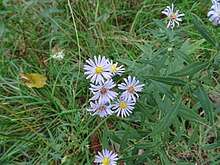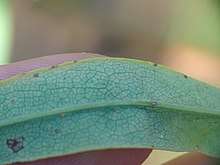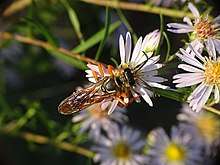Symphyotrichum praealtum
Symphyotrichum praealtum, known as willowleaf aster and willow aster[3] is a species of flowering plant in the aster family, Asteraceae. It is native to North America and introduced in Europe.[3]
| Symphyotrichum praealtum | |
|---|---|
 | |
| Scientific classification | |
| Kingdom: | Plantae |
| Clade: | Tracheophytes |
| Clade: | Angiosperms |
| Clade: | Eudicots |
| Clade: | Asterids |
| Order: | Asterales |
| Family: | Asteraceae |
| Genus: | Symphyotrichum |
| Subgenus: | Symphyotrichum subg. Symphyotrichum |
| Section: | Symphyotrichum sect. Symphyotrichum |
| Species: | S. praealtum |
| Binomial name | |
| Symphyotrichum praealtum | |
| Synonyms | |
|
Aster praealtus | |
Description

Symphyotrichum praealtum is a perennial, herbaceous plant with long rhizomes.[3] The thick, firm leaves have conspicuous reticulate venation below.[4] Flowering occurs from August to November,[5] by which time the lower leaves are often withered.[3] The dense arrays of flower heads are present on the upper, branched portion of the stem. The ray florets are pale violet or lavender and the disc florets are cream or pale yellow.[3]
Taxonomy
Symphyotrichum praealtum was formerly included in the large genus Aster as Aster praealtus. However, this broad circumscription of Aster is polyphyletic and the North American asters are now mostly classified in Symphyotrichum and several other genera.[6]
Several varieties of Symphyotrichum praealtum have been recognised, but these are not consistently recognised.[3] Hybridisation with Symphyotrichum lanceolatum and Symphyotrichum firmum has been reported.[3]
Distribution
Willowleaf aster is native to much of the eastern and central United States, to the Mexican states of Chihuahua, Coahuila, and Nuevo Leon, and to the extreme southern portion of Ontario, Canada.[3] It has been introduced to central Europe.[3]
Habitat
Symphyotrichum praealtum is found in moist, open habitats including wet prairies and meadows, shores, oak savannahs, ditches and roadsides.[3] Periodic disturbance, such as wildfire, drought or human clearing, is required to maintain open habitats suitable for the species.[5]
Ecology

Symphyotrichum praealtum spreads via rhizomes to form large clonal colonies. The species does not self-pollinate; cross-pollination with a genetically distinct plant is required for the production of seeds. The seeds are wind-dispersed.[5]
In some areas, this species may be the latest-flowering plant, which may limit the number of insects available to serve as pollinators.[5]
Conservation
Willowleaf aster is considered globally secure.[1] However, it is legally listed as endangered in New Jersey and threatened in Ontario. In Ontario it is threatened by habitat loss, invasive species, and a reduction or elimination of natural wildfire. There are under 15 populations known to remain in the province, most of which are within the city of Windsor. To protect these populations, tens of thousands of willowleaf aster plants were moved out of construction areas and replanted elsewhere during construction of the Rt. Hon. Herb Gray Parkway.[5]
References
- "Symphyotrichum praealtum". NatureServe Explorer. NatureServe. Retrieved 2020-02-07.
- "Symphyotrichum praealtum". ipni.org. International Plant Names Index. Retrieved 2018-09-29.
- Flora of North America Editorial Committee, ed. (2006). "Symphyotrichum praealtum". Flora of North America North of Mexico (FNA). 20. New York and Oxford. Retrieved 2018-09-29 – via eFloras.org, Missouri Botanical Garden, St. Louis, MO & Harvard University Herbaria, Cambridge, MA.
- Reznicek, A. A.; Voss, E. G.; Walters, B. S., eds. (February 2011). "Symphyotrichum praealtum". Michigan Flora Online. University of Michigan Herbarium.
- Jones, J. "Recovery strategy for the Willowleaf Aster (Symphyotrichum praealtum) in Ontario". Ontario Recovery Strategy Series. Ontario Ministry of Natural Resources. Retrieved 7 February 2020.
- Semple, J. C. "An overview of "asters" and the Tribe Astereae". University of Waterloo. Retrieved 22 January 2020.
